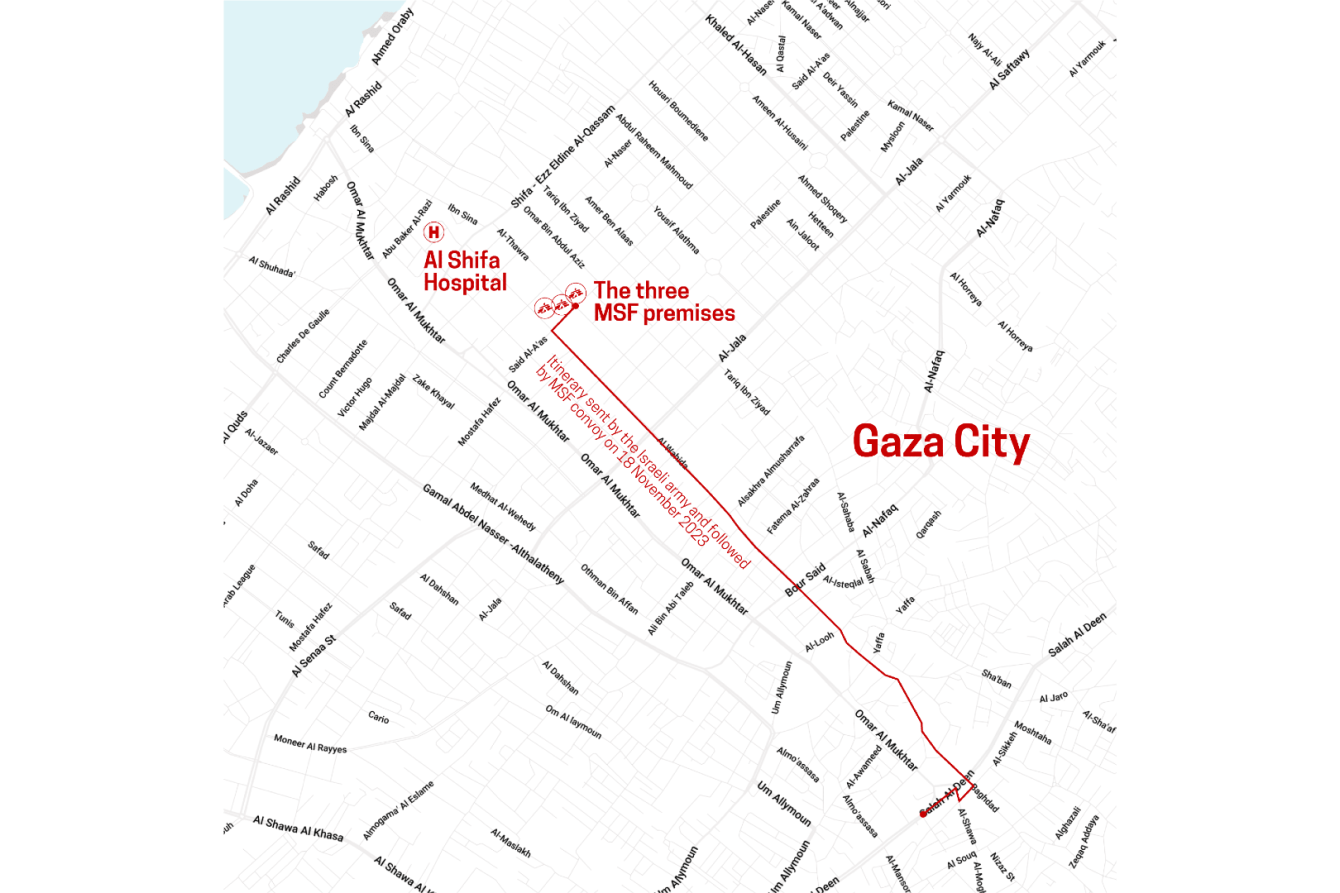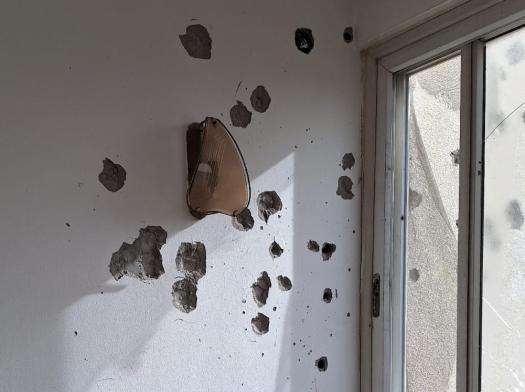On November 18, 2023, a Doctors Without Borders/Médecins Sans Frontières (MSF) evacuation convoy came under fire in Gaza City in what immediately appeared to be a deliberate attack against clearly identified MSF vehicles. Two people were killed—both family members of MSF staff—including one who was a volunteer supporting MSF medical teams at Al-Shifa Hospital.
Two weeks later, after collecting the testimonies of MSF staff who were present in the convoy that day, all elements point to the responsibility of the Israeli army for this attack.
MSF has also collected testimonies regarding the destruction of five MSF vehicles and the severe damage caused to our clinic in Gaza City on November 20. The vehicles and clinic were all clearly identifiable by the MSF logo. Their destruction can be attributed to an Israeli bulldozer and a heavy military vehicle. Before they were destroyed, these MSF vehicles were potential evidence for any independent investigation into the November 18 attack on the MSF convoy.
In addition, shots were aimed at the MSF facilities where these colleagues were sheltering, leaving bullet holes in the interior walls. On November 24, our staff witnessed the destruction of a minibus, also clearly identified by the MSF logo, by an Israeli tank. The MSF team in southern Gaza had sent this minibus following the destruction of the other vehicles a few days prior, to facilitate the evacuation of colleagues in the north.
The staff and family members who went through this ordeal had been trapped inside MSF facilities amid heavy fighting, with no electricity and limited access to food and water, for almost two weeks before they were finally able to evacuate to southern Gaza on November 24. These are their words, recorded between November 26 and 29.

November 18: Israeli forces kill MSF volunteer and another staff family member
On November 18, an MSF convoy of five cars, all clearly identified by the MSF logo, left MSF premises (guesthouse, office, and outpatient clinic) and headed to southern Gaza to reach a safer place. Since November 11, they had been trapped by ongoing fighting and since then, MSF has repeatedly called for their safe evacuation.
MSF had informed both parties to the conflict of the evacuation. The convoy followed the itinerary indicated by the Israeli army and reached Salah Al-Deen Street along with other civilians trying to leave the area.

The convoy reached the last checkpoint near Wadi Gaza, which was overcrowded at that time due to extensive screenings of Palestinians by Israeli forces. Despite prior authorization from Israeli authorities, the MSF convoy wasn’t allowed to cross the checkpoint and was left waiting for hours. Shots were later heard by our staff, who out of fear decided to head back to the MSF premises, around four and a half miles north of the checkpoint.
My colleagues in the cars said: ‘Let’s go back, our only shelter is the MSF Gaza office.’
We contacted Paul [an MSF colleague in Jerusalem] to inform him that we would head back because we were not allowed to pass the checkpoint. He said he would ask for authorization for us to go back.” — MSF staff member 1
On their way back, between 3:30 p.m. and 4:00 p.m. local time, the convoy was attacked on Al-Wahida Street near its junction with Said Al-A’as Street, close to MSF’s office. Two of the MSF cars were deliberately hit, killing a nurse who volunteered with MSF teams and injuring the family member of another staff member, who later also died from his wound.
They started opening fire at us and when a bullet grazed my forehead, I got a superficial injury. The bullet hit my colleague Alaa in the head, he sat next to me. He got a critical head injury and started bleeding massively.
His head fell on the steering [wheel] and I immediately retook control of the [vehicle] to move to the right of the street.” — MSF staff member 2


November 20: Five MSF vehicles destroyed by Israeli forces
Once the tanks moved a little further away, I started filming, though I was scared. It was a terrible, frightening sight.
My colleagues were in the clinic and I was afraid the fire could reach them. The fire crept up along the trees [by the clinic]. The electrical wiring also caught fire. It was a horrible scene.” — MSF staff member 1


Destruction from the attack. Photos taken on November 24. Palestine 2023 © MSF
I was in the clinic. The fire and the smoke came inside. We stood there, thinking about how to stop the fire. So we moved the children and the women through the back doors to the other building, where MSF has the physiotherapy department.” — MSF staff member 2
Thank goodness, someone replied and said they were unhurt, and were also worried about us.” — MSF staff member 1

November 24: More MSF vehicles destroyed
The first day of the truce at 4.30 a.m., an Israeli tank destroyed the MSF minibus and cars that had been sent to us [from the south of Gaza] for our evacuation.” — MSF staff member 2
As the only vehicles available to the staff and their family members had been destroyed, our teams based in the south of the Gaza Strip sent more vehicles to Gaza City to attempt another evacuation. However, they were also hit by bullets while approaching the MSF clinic, and the evacuation was canceled. On November 24, those vehicles were also destroyed by Israeli forces.
Eventually, our colleagues and their families were able to reach the south once the truce came into effect on the morning of November 24, thanks to the vehicles of other civilians evacuating.
MSF has requested a formal explanation for this attack from Israeli authorities and calls for an independent investigation to establish the facts and who is responsible.
We extend our deepest condolences to the families of the victims.





